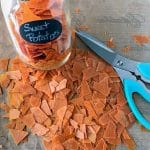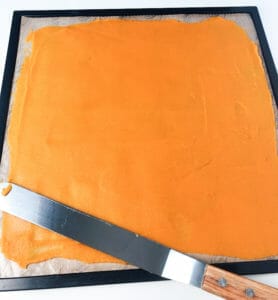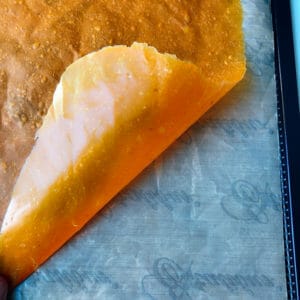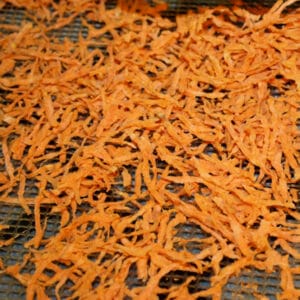How to Dehydrate Sweet Potatoes
Learn how to dehydrate sweet potatoes for use at home or on the trail.
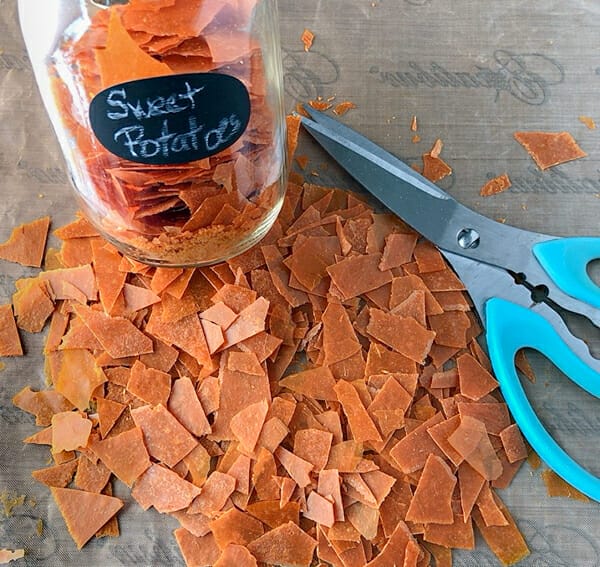
Also Read: How to Make Dehydrated Potatoes, How to Store Dehydrated Food, Top Tips for Dehydrating Food
Dried sweet potatoes are a great addition to your pantry. They re-hydrate very well and can be used at home in regular cooking or for making trail food. You can dehydrate sweet potatoes in several ways – sliced, diced, shredded or pureed depending on your end use. Just be sure to cook or blanch sweet potatoes first (read more about this after the recipe).
How To Dehydrate Sweet Potatoes
How to Dehydrate Sweet Potatoes
Ingredients
- 1-3 lbs sweet potatoes
Instructions
- Decide which style of dried sweet potatoes you prefer -pureed, slided/diced or shredded.For pureed, sliced or diced version, bake sweet potatoes before dehydrating. For shredded version, shred raw sweet potatoes and blanch before dehydrating.
Pureed/Leather (use baked sweet potato)
- Bake: Preheat oven to 350°F(180°C). Wash and trim any blemishes from sweet potatoes. Pierce each sweet potato 3-5 times with fork or knife. Place on baking tray and bake for 35-45 minutes until tender throughout. Remove from oven, let cool and peel. Use for leather, pieces or slices as shown below.
- Mash or puree sweet potato in blender, food processor or with potato masher until smooth. Add a little water if needed. You can also add sweetener or seasoning if you'd like, but do not add oil, butter or other fats.
- Spread thinly (1/8-1/4 inch) and evenly on lined dehydrator tray.
- Dehydrate at 135°F (58°C) until uniformly colored, dry and leathery throughout, approximately 6-8 hours. To test for doneness, press the leather with flat fingers. If your hand leaves an indentation, it is not ready. If the leather feels moist or sticky, it is not ready. Look for color variations, wet spots may be lighter or darker in color. Try pulling it off the liner, if bits stick to the sheet, it is not done. Return to dehydrator until all parts are uniformly dry and the leather pulls off the sheet cleanly and easily. If eating like a fruit roll up, dry to this leathery stage. If using in recipes or to re-hydrate as mashed sweet potatoes, dry even longer until it is brittle and easily breaks into small pieces.
Sliced or Diced Pieces (use baked sweet potato)
- Bake: Preheat oven to 350°F(180°C). Wash and trim any blemishes from sweet potatoes. Pierce each sweet potato 3-5 times with fork or knife. Place on baking tray and bake for 35-45 minutes until tender throughout. Remove from oven, let cool and peel. Use for leather, pieces or slices as shown below.
- Cut baked sweet potatoes into consistent sized slices about 1/8-1/4 inch thick or into 1/4-1/2 inch dices. Lay out evenly on mesh dehydrator trays. Place any bits and pieces on a separate dehydrator tray as they will likely dry quicker.
- Dehydrate sliced or diced pieces at 125°F (52°C) until brittle or very tough and leathery throughout. Split in half to ensure inside is thoroughly dry with no soft or damp spots. The photo below shows the outside completely dry while the inside is still soft and damp. Dehydrating time will vary, slices will take 8-10 hours and diced will take 10-12 hours.
Shredded Pieces (use raw and blanch)
- Blanch: Peel raw sweet potatoes and use the coarse side of a box grater or a coarse shredding blade of a food processor to shred. Place shreds in cold water to rinse off some of the starch and prevent discoloring. Bring large pot of water to full boil, remove shredded sweet potatoes from cold water and add to boiling water. Return to full rolling boil and boil for 5 minutes. Remove from hot water and immediately put into ice water. Once cooled, drain well. Place on mesh dehydrator tray spread out as best as possible, some overlapping is okay.
- Dehydrated shredded pieces at 125°F (52°C) until tough, about 6-8 hours.
- Store in airtight containers in a cool, dry, dark place. Use within one year for best quality, although they will be safe for much longer. Vacuum seal if storing for over a year.
Notes
Nutrition Facts (per serving)
Do I Need To Blanch Sweet Potatoes Before Dehydrating?
It is a really, really good practice to get into. I know you’ll find sites that say you don’t have to – but if you want high quality, long lasting results, you really should cook or blanch sweet potatoes before dehydrating.
In fact, the general rule of thumb for vegetables is any vegetable that we typically cook before we eat, should be cooked or blanched before dehydrating. This includes sweet potatoes, potatoes, carrots, peas, green beans, corn, winter squash, beets, etc. Vegetables like peppers, tomatoes, zucchini, etc. do not need to be cooked or blanched.
Blanching or cooking protects against loss of color, texture and flavor. It also decreases the time it takes to dehydrate sweet potatoes and the time it takes to re-hydrate them. Without cooking or blanching, dehydrated sweet potatoes will lose their color and change flavor after about 3 months.
The exception: If you use your dehydrated sweet potatoes within 3 months, you may not notice any quality or flavor changes. If that’s the case, you can dehydrate raw sweet potatoes. But if you’re plans change and you end up with dried sweet potatoes on your shelf – don’t expect the quality to last.
Favorite Ways to Use Dehydrated Sweet Potatoes
Now that I’ve shown you all the different ways to dehydrate sweet potatoes, I’ll confess my two favorite styles are the shredded sweet potatoes and the sweet potato leather (some people refer to brittle vegetable leathers as bark). Usually I make the sweet potato leather when I’m making a batch of mashed sweet potatoes for dinner – I double up and put the extras in the dehydrator before I add any butter or seasonings. I like the shredded sweet potatoes because they re-hydrate quickly and evenly when added to assembled recipes like couscous lentil salad.
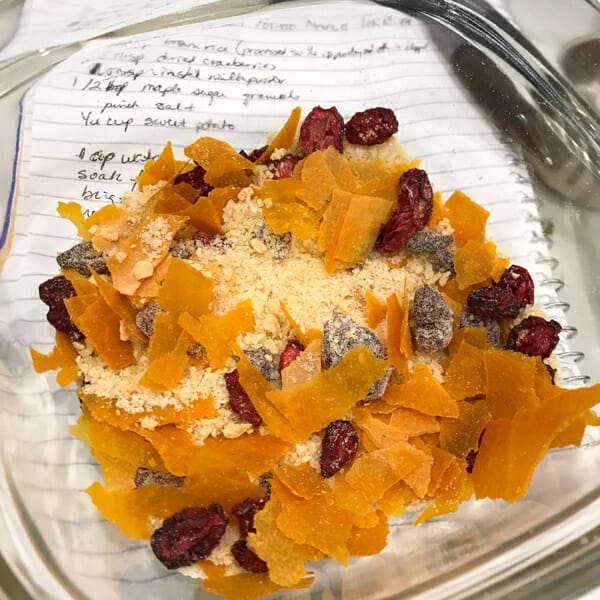
Sweet Potato Leather
Sweet potato leather is easily returned to it’s mashed origins by adding hot water (1/2 cup leather bits + 3/4 cup water per serving). It works beautifully as a side dish at home or on the trail. Once re-hydrated you can use the puree anywhere you would use mashed sweet potatoes or even pureed winter squash or pumpkin. Think sweet potato waffles, butternut squash soup, sweet potato breakfast muffins, etc.

I will break, crumble or cut sweet potato leather into small pieces so they’re easy to store, add to recipes and re-hydrate. My favorite way of using the leather pieces is to add to breakfast meals like oatmeal, brown rice porridge or chia seed pudding. I love that it adds sweetness, extra nutrients and extra calories – something I want to start a long day of hiking, kayaking or outdoor activity. Pieces can also be added to soups, stews and rice dishes.
Shredded Sweet Potatoes
Because they re-hydrate so quickly and evenly, I also like using shredded sweet potatoes at home or on the trail.
At home, if I’m making soups, stews, curries that are very liquidy, I’ll just add the shredded pieces without pre-soaking. If I’m using them in baking, I’ll soak them first in hot water. In this case, I just pour hot water over the shreds and drain them when I’m ready to use them.
When making trail food, I will add dried pieces when I’m assembling recipes like lentil couscous salad, mac and cheese, beans and veggies, etc.
I usually add a total of 1/4 cup of dried veggies per meal per person. The shredded sweet potatoes would be part of that amount.
How to Re-hydrate Sweet Potatoes
Here are some very approximate amounts and re-hydrating times.
Approximate Measures
1lb raw sweet potatoes = 1 cup dried sweet potatoes
Use 1/4 to 1/2 cup dried pieces/shreds/leather pieces per serving
For 1/2 cup dried sweet potatoes use 3/4 cup boiling water
To Re-hydrate
Cover sweet potatoes with boiling water and soak for 10 to 40 minutes. Leather pieces and shredded pieces will re-hydrate the quickest at 10-15 minutes. The thicker the slices or dices, the longer the soaking time. The longer you let pieces soak, the more they will return to their original shape and texture. Once they’re re-hydrated cook, heat or use as you would use any sweet potato.
Which method of dehydrating sweet potatoes do you prefer? Let me know if you dehydrate some and how you use them. I’d love to hear about your experiences. And, if you’re on social media, take a photo and tag #getgettys so I can see it and like it!
Getty Stewart is a Professional Home Economist, speaker, frequent media guest and writer dedicated to putting good food on tables and agendas. She is the author of several recipe books on enjoying and preserving fruit, Founder of Fruit Share, a mom and veggie gardener. Sign up to get articles by Getty delivered to your inbox. You’ll get recipes, practical tips and great food information like this.


